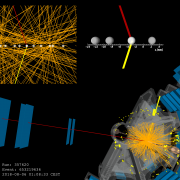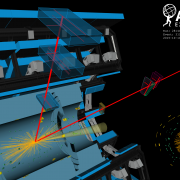Access to Collaboration Site and Physics Results
If all the experimental evidence supports a theory, why should anyone want to dream up additional particles? Yet exactly this situation arose in the late 1960s. At that time, when the complete table of the known hadrons could be explained with just three quarks, theorists were already proposing a fourth, which they whimsically called “charm”. They calculated that the additional particle would increase the symmetry, and so fix some unpleasant mathematical divergences in the three-quark theory. As they correctly predicted, the charm quark does indeed exist, and in 1974 it was discovered experimentally.

Forty years on, many theorists expect an analogous situation may unfold. Our best current theory again explains almost all experimental observations. However the discovery of the Higgs boson has introduced its own mathematical problems – other unpleasant divergences, this time associated with the Higgs boson’s own mass. The theoretically-motivated symmetry that would fix this new problem is supersymmetry. If it is correct, all known particles, including the charm quark itself, should have (as-yet undiscovered) supersymmetric partners. The theory of supersymmetry brings other benefits too – the lightest supersymmetric particle may be the source of the mysterious “dark matter” that dominates the mass of the universe.
In the first dedicated search of its kind, ATLAS has looked for the proposed supersymmetric partner of the charm quark, the so-called “scalar-charm”. The ATLAS team analysed LHC collisions for evidence of a scalar-charm quark being produced along with its anti-particle. Each of the two super-partners is then expected to decay into an (anti-)charm quark together with an invisible dark matter particle of unknown mass.
In the first dedicated search of its kind, ATLAS has looked for the proposed supersymmetric partner of the charm quark, the so-called “scalar-charm”. The ATLAS team analysed LHC collisions for evidence of a scalar-charm quark being produced along with its anti-particle.
The search was made possible by the ATLAS detector’s precision tracking and vertex-finding capabilities, which can detect sub-millimetre distances travelled by charmed hadrons during the picosecond before they decay. The energetic jets of hadrons produced by charmed quarks were identified using an artificial neural-network-based algorithm, optimised to distinguish them from jets from other quarks or gluons. The other characteristic feature exploited by the search was the expected imbalance of observed momentum that is caused when invisible particles, such as dark matter, are produced but not detected.
The team analysed the ATLAS data from proton-proton collisions at centre-of-mass energy of 8 TeV. Their results rule out scalar-charms with masses up to about 540 GeV, depending on the mass of the dark matter particle. The results complement previous ATLAS searches for scalar-bottom and scalar-top quarks, and general searches for squarks and gluinos.








